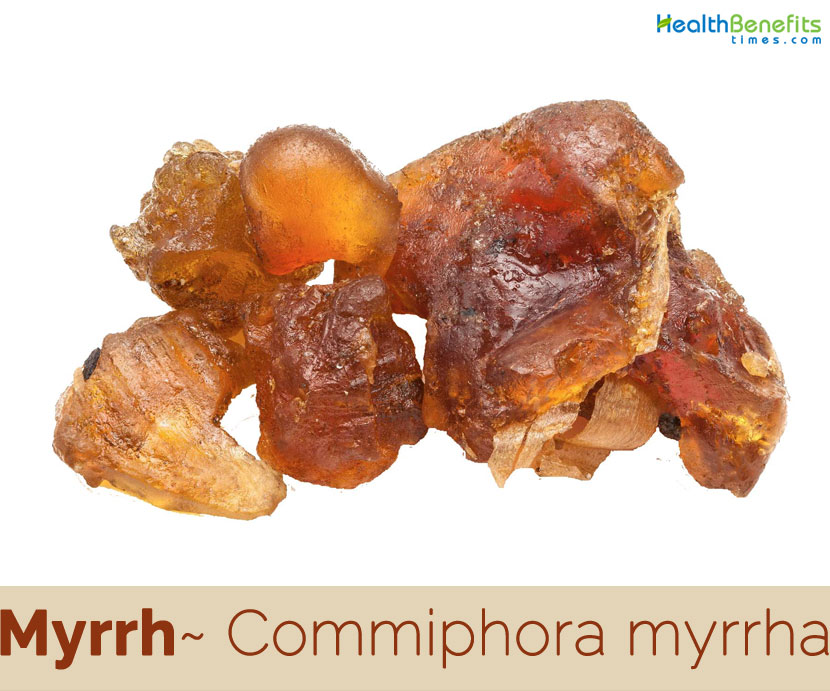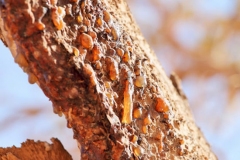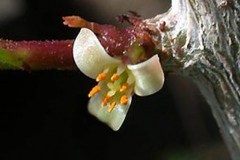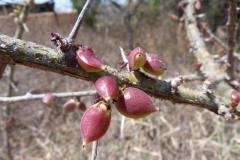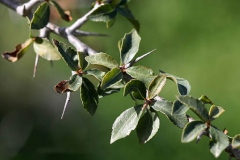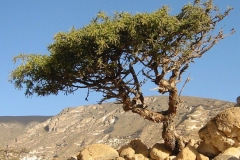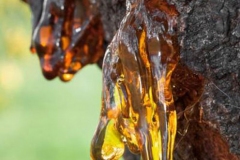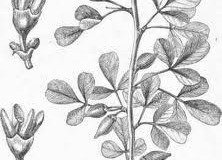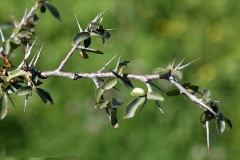Myrrh is a resinous secretion of the Commiphora myrrha trees. Native users collected the resin from myrrh by making incisions into the bark. A yellowish oleoresin is exudate from these bark incision marks. Exposure to air makes the resin dry and hardens, which then gradually turns to reddish-brown. Myrrh has been used in perfumes, incense, and embalming, and, as a symbol of suffering, was one of the three gifts believed to have been offered to the infant Jesus by the Magi. Myrrh is also one of the oldest known medicines and was widely used by the ancient Egyptians. It is an excellent remedy for mouth and throat problems, with a drying, slightly bitter taste, and it is also useful for skin problems.
Myrrh Facts
| Myrrh Quick Facts | |
|---|---|
| Name: | Myrrh |
| Scientific Name: | Commiphora myrrha |
| Origin | Southwest Asia, including Arabia, and most commonly east and northeast Africa |
| Shapes | Ovate, smooth, brown, 2-4 mm long fruit, surrounded at base by a 4-toothed calyx |
| Taste | Bitter, Acrid, Astringent |
| Health benefits | Reduce Headache, Relieve pain, Good for gum health, Help fight germs, Joint Pain alleviation, Anticancer, Candida Infection, Lower back pain, Nail Fungus, Skin Health, Prevent Diabetes, Infection Control, Respiratory Health, Muscle Ache, Menstrual Cramp Treatment, Liver Health, Gastrointestinal Disorders, |
| Name | Myrrh |
|---|---|
| Scientific Name | Commiphora myrrha |
| Native | Southwest Asia, including Arabia, and most commonly east and northeast Africa near the region of the Red Sea or Arabian Gulf, specifically Ethiopia, Somalia, and Kenya |
| Common Names | Myrrh, African myrrh, herabol myrrh, Somali myrrhor, common myrrh, or gum myrrh |
| Name in Other Languages | Arabic: Easra (عصرة) Burmese: Kularr naat sway (ကုလားနက်သွေး) Chinese: Ma Yao, Mo Yao Shu English: African myrrh, herabol myrrh, myrrh, Somali myrrh Finnish: Afrikanmirhapuu French: Arbre à myrrhe, myrrhe German: Myrrhe, Myrrhenstrauch Hindi: Gandh Ras, Bol Hungarian: Szomáliai balzsamfa Italian: Mirra Polish: Balsamowiec mirra Russian: Mirra (Мирра) Somali: Dheddin Spanish: Mirra Ukrainian: Mirra (Мирра) Vietnamese: Một dược (cây) |
| Plant Growth Habit | Small thorny, deciduous tree or a large shrub |
| Growing Climates | Thickets in desert scrubland, open Acacia, shallow soil, chiefly over limestone |
| Soil | Does best in thin soil, primarily in areas with limestone |
| Plant Size | Up to 5 m high and 1.5 m wide |
| Bark | Smooth, thin, flaking off in small portions, pale orange brown, becoming ash grey when detached |
| Trunk | Thick, light gray trunk with sharp spines protruding from its main branches. |
| Leaf | Up to 5 m high and 1.5 m wide. The leaves are oblong to oval and have 3 leaflets per leaf. Each leaflet is about 1 cm long |
| Flower | Tiny and inconspicuous, borne in more or less clustered panicles. All Commiphora species are dioecious |
| Fruit Shape & Size | Ovate, smooth, brown, 2-4 mm long fruit, surrounded at base by a 4-toothed calyx |
| Propagation | From seed in spring or from cuttings at the end of the season |
| Flavor/aroma | Aromatic odor |
| Seed | Smooth with gentle swellings |
| Taste | Bitter, Acrid, Astringent |
| Plant Parts Used | Resin from stems, gum, stem, leaves, essential oil |
| Available Forms | Tincture or in dental powders, tea, rinses, and gargles. |
| Health Benefits |
|
Plant Description
Myrrh is a small thorny, deciduous tree or a large shrub that normally grows up to 5 m high and 1.5 m wide. The plant is found growing in thickets in desert scrub land, open Acacia, shallow soil, chiefly over limestone. The plant does best in thin soil, primarily in areas with limestone. The plant has a thick, light gray trunk with sharp spines protruding from its main branches. C. myrrha is a very variable species. The different forms seem to merge so imperceptibly that the recognition of infra specific taxa is often difficult.
Stem
Trunk is swollen, flaky, thick, and hairless throughout, it has peeling silvery, whitish, reddish or bluish grey papery-bark, the under-bark is green and photosynthetic, it produces knotted spiny branches, and branchlet that stand out at right-angles, ending in a sharp spine. Stem exudate a hardly scented, viscid, translucent yellowish gum-resin. The wood is yellowish-white.
Leaves
Leaves are chartaceous, greyish green or glaucous, very variable with petiole 1–10 mm. long. Few lateral leaflets are sometimes very minute, may nearly always be found on both long- and short-shoot leaves, but most leaves may be without them or they may be up to half the size of the terminal leaflet, which maybe elliptic, spathulate or lanceolate, attenuate, cuneate, rounded or truncate at the base, rounded or acute apically, 6–44 mm. long, 3–20 mm. wide, with 3–4 rather weak main veins on each side, ultimate vein network obscure; margin entire or with up to 6 rather large broad teeth on each side. The tree sheds its leaves in autumn and the leaves turn yellow before falling off.
Flower
Tiny and inconspicuous, borne in more or less clustered panicles. All Commiphora species are dioecious. Male flowers usually precocious, 3-4 mm long which are often sparsely glandular. Bracteoles are pale brown, ovate-triangular, 0.5–0.7 mm. long and wide, often lightly attached at the base and forming a fragile detachable collar. Receptacle is beaker-shaped, ± 2 mm. deep and 2.3 mm. wide. Calyx-tube is 1 mm. lobes ovate-triangular 1.5 mm. long. Petals are oblong, tapering, pointed and recurved at the tip, 4.5 mm. long and 1.5 mm. wide. Filaments are 1.4 and 1.2 mm, anthers 1.2 and 1.0 mm. long.
Fruit
Fertile flowers are followed by Ovate, smooth, brown, 2-4 mm long fruit, surrounded at base by a 4-toothed calyx, and supported on a very short stalk. Seeds are smooth with gentle swellings. Myrrh is propagated from seed in spring or from cuttings at the end of the growing season.
Health benefits of Myrrh
Below are some of the popular health benefits of using myrrh
1. Reduce Headache
Extract of Myrrh consists of good amount of bioactive phytochemical furanodienes which actually has the strength to ease headache. Research conducted in both male and female participants reported that Myrrh help to reduce the pain score of the subjects with a headache. Research also described that a minimum dose of Myrrh is quite effective to manage headache.
2. Relieve pain
Since ancient times, Myrrh has been used to treat pain, but research done within the past couple of decades has sought to explain why it works. Research on combined effects of frankincense and myrrh found that a water extract made from both resins inhibited a specific neurotransmitter in mice responsible for causing pain, while yet another study conducted on mice with chronic pain found that myrrh has the potential to help patients struggling with neuropathic pain. Since this mouse study is not 100 percent conclusive, but the results are certainly motivating.
3. Good for gum health
Anti-inflammatory properties of myrrh oil may help treat gingivitis, though more research is needed. However, research has discovered that myrrh-containing mouthwashes promote the healing of oral wounds. It is also recommended not to use myrrh-based products for more than two weeks at a time or in large doses, as the extract could end up damaging tissue.
4. Help fight germs
Myrrh is mostly used as an antiviral and antibiotic. It helps to encourages white blood cells to help your immune system fight infections, and additionally has direct antimicrobial effects. It is commonly used for dealing with common cold, respiratory infections, sore throat, ear infections, and swollen lymph nodes.
5. Joint Pain alleviation
Application of Myrrh extract is an effective treatment to treat joint pain including osteoarthritis. Analgesic property of Myrrh not only effective to control pain in the joints also reduces the stiffness. Thus, patients with mild osteoarthritis get benefitted by application of Myrrh oil. Myrrh extract consists of sufficient amount of calcium which helps to maintain bone health.
6. Anticancer
According to a research published in the November 2007 issue of “Holistic Nursing Practice.” Terpenoid compounds present in myrrh give it potential anticancer benefits. Researchers also concluded that myrrh offers potential as a natural therapy for treating prostate cancer.
7. Candida Infection
Prepare a soft gelatin capsule by encapsulating 2 drops of Oregano oil and Myrrh oil along with 4 drops Melaleuca and Coconut oil. Take this combination therapy trice a day with a meal to deal with Candida Infection.
8. Lower back pain
Back pain becomes a common pain symptom due to improper postural issues, or strenuous physical activity. Instead of using frequent synthetic analgesic medication, Myrrh extract is an effective alternative treatment of lower back pain. According to one clinical research 400 mg of Myrrh extract is effective to deal with the condition.
9. Nail Fungus
Prepare an herbal preparation by including 1 drop of Oregano oil, 2 drops of Myrrh and 4 drops of Melaleuca and Lavender oil. Apply this combination therapy on around the nail bed and on the top of the nail twice a day until the infection decreased.
10. Skin Health
Ancient Greeks and Romans were surely on the right track by using Myrrh to treat wounds. Scientific research now confirms that Myrrh essential oil when mixed with Sandalwood is effective at killing the microbes that infect skin wounds. Another research found that Myrrh essential oil used alone prevents the growth of the fungi that causes athletes foot by 43 – 61 percent. Apart from that many other skin conditions, including; weeping eczema, bedsores, boils, acne and deeply chapped skin can be cured using myrrh.
11. Prevent Diabetes
Experts often suggested chromium supplement to individuals who have a higher risk to develop diabetes, as deficiency of chromium has co-relation with diabetes prevalence. Myrrh has a sufficient amount of chromium in it and may be effective to prevent diabetes.
12. Infection Control
Myrrh consists of good amount of Curzerene and sesquiterpenoids which have antibacterial, antifungal, and anesthetic property, which protects against infection.
13. Respiratory Health
Myrrh is considered a powerful decongestant. Diffusing Myrrh essential oil in an aromatherapy oil burner can clear excessive mucus and provide relief from coughs, colds, bronchitis and asthma.
14. Muscle Ache
Muscle ache with joint pain symptom is a common distressing condition often related with other ailments like a fever. This type of pain also occurs after active physical activity. Research concluded that 400mg of Myrrh extract is effective to treat muscle ache.
15. Menstrual Cramp Treatment
Due to its analgesic property, Myrrh is effective to treat menstrual cramps or dysmenorrhea if the symptom is not related with an organic cause. Myrrh extract with 200 mg dose is an effective treatment to control dysmenorrhea. Sufficient amount of iron is also present in Myrrh, which may prevent amenorrhea.
16. Liver Health
Research at the Beni-Suef University in Egypt concluded that Myrrh can actually detoxify what the liver cannot – particularly, ammonia. When the liver cannot eliminate dangerous substances sufficiently, they build up in the bloodstream. For example, ammonia, a by-product of protein digestion, needs to be converted into urea in the liver and eliminated via the kidneys. Accumulation of ammonia in the blood, called hyper-ammonaemia, is toxic to nerves and can lead to a weakening of brain functions known as hepatic encephalopathy. Excessive ammonia is mostly dangerous because it worsens the over-production of nitrogen and oxygen free radicals.
17. Gastrointestinal Disorders
Limonene, a monoterpene present in myrrh resin is considered effective to treat cholesterol-containing gall stones. It can also control gastro esophageal reflux disease (GERD). Thus, myrrh resin can control heartburn symptom.
Traditional uses and benefits of Myrrh
- Resin encourages healing and relieves spasms, inflammation and digestive discomfort.
- If taken internally, it treats dyspepsia, infections of the ear, tonsillitis, fever, etc.
- Resin yields essential oil which is used for treating skin and mouth problems.
- Plant can be used externally to deal with wounds, boils, and mouth ulcers, and added to oral preparations.
- It relieves spasms; inflammation and digestive discomfort, and encourages healing.
- It is particularly related with women’s health and purification rituals.
- Resin can be taken internally in the treatment of dyspepsia, bronchial and ear infections, glandular fever, tonsillitis, pharyngitis, gingivitis, menstrual and circulatory problems.
- It is one of the most effective herbal medicines for treating sore throats, mouth ulcers and gingivitis.
- Mild astringency makes it a useful treatment for acne, boils and mild inflammatory skin problems.
- An essential oil obtained from the resin is used by aroma therapists as a natural antiseptic for treating skin and mouth problems.
- It has been used as an astringent, antiseptic, anti-parasitic, antitussive, emmenogogue, and antispasmodic agent.
- Myrrh has also been reported to treat gout, headache, jaundice, throat ailments, indigestion, fatigue, and paralysis.
- Myrrh has been used in a variety of infectious diseases, including leprosy and syphilis, and to treat cancers.
- The Chinese have used myrrh in the management of a variety of skin and mouth infections.
- It has also been used as an astringent, as an antiseptic to be applied to inflamed sores of the throat and mouth, to stimulate menstruation, as an antispasmodic, and for the treatment of cancer and infectious diseases.
- As a wash it is good for spongy gums, ulcerated throat and aphthous stomatitis, and the tincture is also applied to foul and indolent ulcers.
- It has been found helpful in bronchorrhoea and leucorrhoea.
- It is used in the East Indies in leprosy, rheumatism and syphilis, and in Europe for plasters.
- In folk medicine, myrrh has been used internally for colds, coughs, indigestion, asthma, arthritis pain, leprosy, cancer, syphilis, chlorosis, diphtheria, dysmenorrhea, tuberculosis, and to increase milk flow.
- It has been used by women to stimulate menstrual flow and help relieve menopausal symptoms.
- It has also been used in mouthwash and gargles to fight bad breath and infections, and to help heal mouth sores and loose teeth.
- Myrrh has astringent properties that help bind skin to create a barrier against infection.
- Powdered myrrh is used in Germany to treat throat and mouth inflammation.
- Mixed with boric acid and boiling water, myrrh can be used as a gargle for oral inflammation, a sore throat, and gum issues.
Ayurvedic Health benefits of Myrrh
- Aphthous Ulcers: Mix 250-350 mg of herb extract with warm water and swish with it 2-3 times a day. OR: Prepare Myrrh tincture. Take 5 ml and mix it with warm water. Swish with it 2-3 times a day. Else: Open a Myrrh capsule. Dab a little directly on the Mouth Ulcers.
- Sore Throat: Consume 4 g Myrrh powder with lukewarm water twice a day.
- Nipple Discharge: Apply the tincture of Myrrh over the nipples.
- Gum Diseases: Take Myrrh tincture and put 8-10 drops in a cup of warm water. Use as a mouth wash several times a day.
- Infections Combo: Take Wild Indigo, Echinacea and Myrrh in equal quantity. Prepare a decoction. Take twice a day.
- Gingivitis: Take Catechu, Wild Geranium and Myrrh. Powder them. Add a little clove Use it as a tooth powder.
- Ulcers: Mix Frankincense gum, Myrrh gum, Catechu resin and Ginseng Noto root powder. Apply it locally on ulcers.
- Aphthous Ulcers: Prepare Licorice root tea. Add 2-3 drops of Myrrh oil and Aloe Vera Drink once a day.
- For Wounds, Bruises, Sprains and Burns: Take 4 tablespoons Myrrh, 2 tablespoons Goldenseal and 1 tablespoon Cayenne Pepper. Mix all these and put in a quarter of rubbing Alcohol. Keep it stand for 8-10 days, shaking the mixture daily. Use it as a liniment for wounds, sprains, burns, bruises and wherever a liniment is needed.
- Sore Throat: Put two chopped Parsley leaves, 2-3 Clove, One tablespoon powdered myrrh, and 1/4 tsp. of powdered goldenseal in one glass of boiled water. Strain and Drink decoction two-three times a day.
- Cuts: Make a paste by adding equal amount of Myrrh and Golden seal. Apply.
- Diptheria: Mix one tablespoon each of Mullein, Raspberry leaves, Agrimony, Bayberry, Cayenne and Myrrh. Prepare a decoction. Have one glass two times a day.
- Herpes: Take 4-5 drops of Tea Tree essential Oil and 2-3 drops of Myrrh Oil. Mix them with half teaspoon each of St John’s Wort and Licorice Root. Put all these ingredients in an airtight jar and place away from heat and sunlight. Shake well and directly apply thrice a day.
- Age Spots: Take 10 gram Rosewood oil, 10 gram Myrrh Oil, 10 gram Chamomile Oil, 10 gram Orange Oil, 10 gram Mandarin Orange Oil, 10 gram Patchouli Oil and 10 gram Sage Oil. Put all ingredients in a vessel. Heat for 5 minutes. Store in a glass bottle. Massage over affected area with this preparation for 10 minutes.
- Stomatitis: Myrrh mixed with equal parts of honey and rectified spirit and dissolved in rose water or infusion of rose petals (50 parts) is effective in stomatitis.
- Galactogogue: Myrrh increases milk secretion if used with jaggery.
- Oral Problems: Decoction of myrrh strengthens the teeth & remove bad odor of mouth.
Culinary Uses
- Bark yields a fragrant resin used as flavoring fir sweets, baked goods, beverages, chewing gum, and desserts.
- Myrrh is used as a flavoring agent in beverages, candy, baked goods, chewing gum, gelatin, frozen desserts, puddings, soft drinks, and meat products.
Other Facts
- Hard, translucent, yellowish gum-resin is obtained from wounds in the stem.
- It has an aromatic taste and odor, but may be acrid and bitter.
- It is inflammable, but burns feebly.
- Fragrant resin is used for perfumery and as incense during religious ceremonies.
- It was also originally used in embalming.
- Myrrh is a common ingredient of tooth powder, and is used with borax in tincture, with other ingredients, as a mouth-wash.
- An essential oil can be obtained from the plant.
- The oil is deep amber in color with a warm, spicy, bitter and smoky aroma.
- Myrrh oil is considered helpful for meditation, and aroma therapists recommend the naturally antiseptic essential oil for skin and mouth problems.
- Myrrh has been used for centuries as incense and for medicinal purposes.
- It is an ingredient in mouthwashes and toothpastes, as well as being available as a liquid extract and encapsulated dried extract.
- Myrrh is traditionally used as burned incense which repels fleas and mosquitoes.
Precautions
- This herb is contraindicated during pregnancy because of its emmenagogic activity.
- It is advisable to dilute myrrh before use and administer moderate doses.
- Allergic reactions have been observed.
- Avoid use during Pregnancy and breast feeding.
- Avoid use in case of weak stomach as it may cause vomiting and nausea.
- Do not use for a prolonged period of time.
- Breast-feeding mothers should also avoid using myrrh.
- Myrrh might lower blood sugar. If you use myrrh as well as medications for diabetes, monitor your blood sugar carefully.
- Myrrh might make a fever worse. Use with caution.
- Large amounts of myrrh can affect heart rate. If you have a heart condition, get your healthcare provider’s advice before starting myrrh.
- If you have systemic inflammation, use myrrh with caution, since it might make this condition worse.
- Myrrh seems to be able to stimulate uterine bleeding, which is why some women use it to start their menstrual periods. If you have a uterine bleeding condition, use myrrh with caution, since it might make this condition worse.
References:
https://pfaf.org/user/Plant.aspx?LatinName=Commiphora+myrrha
https://www.drugs.com/npc/myrrh.html
https://botanical.com/botanical/mgmh/m/myrrh-66.html
https://plants.usda.gov/core/profile?symbol=COMMI2
https://npgsweb.ars-grin.gov/gringlobal/taxonomydetail.aspx?id=402550
https://davesgarden.com/guides/pf/go/133259/#b
https://gd.eppo.int/taxon/COQMY
http://www.theplantlist.org/tpl1.1/record/kew-2733595
https://en.wikipedia.org/wiki/Commiphora_myrrha
http://www.plantsoftheworldonline.org/taxon/urn:lsid:ipni.org:names:127741-1


